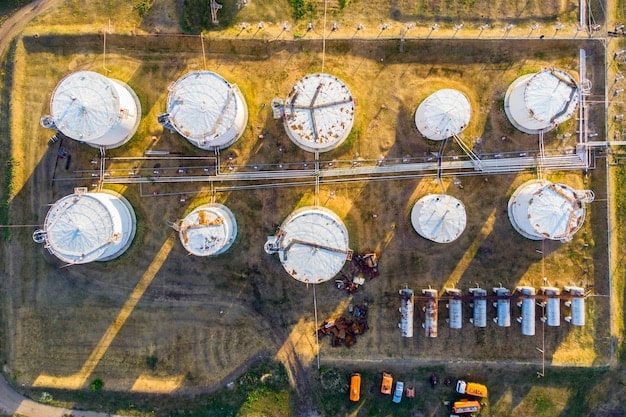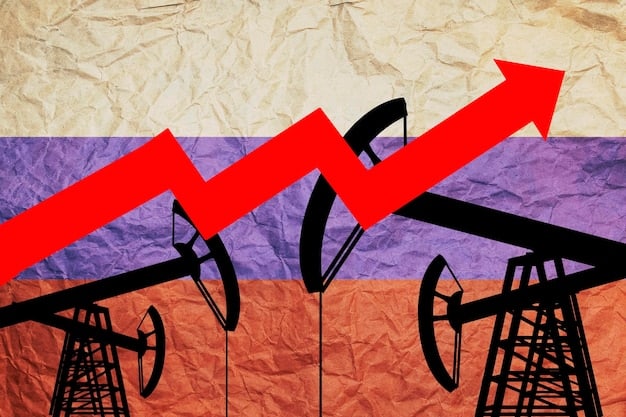Oil Prices Hit $95: Consumer Impact & Financial News Analysis

Financial News: The recent surge in oil prices to $95 a barrel is poised to significantly impact consumers through increased energy costs, higher prices for goods and services, and potential inflationary pressures across the US economy.
The **financial news** is buzzing with reports of oil prices surging to $95 a barrel, a level not seen in quite some time. This increase is not just a number; it has the potential to ripple through the entire economy, impacting consumers in various aspects of their daily lives. Understanding the causes and potential consequences is crucial for navigating the changing economic landscape.
Oil Price Surge: Understanding the $95 Threshold
The rise in oil prices is a complex issue driven by a multitude of factors. Understanding these factors is crucial to grasp the full implications of this surge and its potential knock-on effects.
Geopolitical Tensions and Supply Concerns
Geopolitical instability in oil-producing regions often leads to supply disruptions or fears thereof, driving up prices. These tensions can disrupt production, creating uncertainty in the market.
Increased Global Demand
As economies recover and expand, the demand for oil typically increases, putting upward pressure on prices. Increased travel and industrial activity contribute to this demand.
Here are some key factors influencing the current oil price surge:
- Geopolitical Risks: Ongoing conflicts and instability in key oil-producing regions.
- OPEC+ Production Cuts: Decisions by OPEC+ to limit oil production impacting supply.
- Economic Recovery: Increased demand due to the global economic recovery gaining momentum.
- Seasonal Factors: Higher demand during peak travel seasons.
The confluence of these factors has created a perfect storm, pushing oil prices to levels that are causing concern for consumers and businesses alike. Monitoring these factors is critical for anticipating future price movements.

Direct Impact on Consumers: The Gas Pump and Beyond
The most immediate and visible impact of rising oil prices is felt at the gas pump. However, the effects extend far beyond filling up your car.
Rising Gasoline Prices
As crude oil prices increase, gasoline prices invariably follow, directly impacting household budgets. Commuting and travel become more expensive.
Increased Transportation Costs
Higher fuel costs for transportation companies lead to increased prices for goods and services. This affects everything from groceries to online shopping.
Here’s how the oil price surge directly affects consumers:
- Higher Gasoline Prices: More expensive to fill up your car.
- Increased Transportation Costs: Higher prices for goods transported by trucks, trains, and planes.
- Impact on Travel: More expensive airfares and road trips
- Potential Inflation: Rising prices across various sectors due to increased energy costs.
The ripple effect of rising oil prices touches nearly every aspect of the consumer economy, leaving households with less disposable income.
Broader Economic Consequences: Inflation and Recession Risks
Beyond the direct impacts on consumers, rising oil prices can have significant macroeconomic consequences. These include inflationary pressures and even increased risks of economic recession.
Inflationary Pressures
Higher energy costs can contribute to overall inflation, as businesses pass on their increased expenses to consumers. This can erode purchasing power.
Impact on Businesses
Businesses face higher operating costs due to increased energy expenses, potentially leading to reduced investment and hiring. This can slow down economic growth.
Increased oil prices can significantly impact the broader economy:
- Inflation: Rising energy costs contribute to overall price increases.
- Business Costs: Higher operating expenses for businesses reliant on energy.
- Consumer Spending: Reduced disposable income impacting overall spending levels.
- Economic Growth: Potential slowdown in economic activity due to decreased investment.
These broader economic consequences can create a challenging environment for consumers and businesses alike, requiring careful economic management.

Government Policies and Potential Interventions
Governments have several tools at their disposal to mitigate the impact of rising oil prices. These include strategic oil reserve releases, tax adjustments, and diplomatic efforts to stabilize the market.
Strategic Oil Reserve Releases
Releasing oil from strategic reserves can temporarily increase supply and ease price pressures. This provides short-term relief to the market.
Tax Adjustments
Governments can reduce taxes on gasoline to lower prices at the pump. This can provide direct relief to consumers.
Governments can intervene in several ways to manage rising oil prices:
- Strategic Petroleum Reserve: Releasing reserves to increase supply.
- Tax Policies: Adjusting taxes on gasoline to lower prices.
- Diplomatic Efforts: Working with other nations to stabilize oil markets.
- Energy Policies: Incentivizing renewable energy sources to reduce dependence on oil.
The effectiveness of these interventions varies depending on the specific circumstances and policy choices made.
Expert Opinions and Industry Analysis
Industry experts and analysts offer valuable perspectives on the drivers and potential impacts of rising oil prices. Their insights can help consumers and businesses make informed decisions.
Market Predictions
Analysts provide forecasts on future oil price movements based on various economic and geopolitical factors. These predictions can help in planning and budgeting.
Impact Assessments
Experts assess the potential impact of rising oil prices on different sectors of the economy. This helps businesses anticipate and prepare for changes.
Expert opinions play a crucial role in understanding oil price dynamics:
- Market Forecasts: Predictions on future oil price trends.
- Economic Impact Analysis: Assessments of how rising prices will affect various sectors.
- Policy Recommendations: Suggestions for government interventions.
- Investment Strategies: Insights for investors in the energy sector.
Staying informed about expert opinions and industry analysis can provide a more nuanced understanding of the oil market.
Strategies for Consumers: Adapting to Higher Oil Prices
Consumers can take proactive steps to mitigate the impact of rising oil prices on their budgets. These strategies include reducing energy consumption, exploring alternative transportation options, and making informed purchasing decisions.
Reducing Energy Consumption
Conserving energy at home and in transportation can help lower overall expenses. Simple changes can make a big difference.
Exploring Alternative Transportation
Consider using public transportation, biking, or walking instead of driving. This can save money and reduce your carbon footprint.
Here are some strategies for consumers to cope with higher oil prices:
- Conserve Energy: Reduce energy consumption at home and while driving.
- Use Public Transportation: Opt for buses, trains, or subways.
- Carpooling: Share rides with colleagues or neighbors.
- Shop Wisely: Compare prices and buy energy-efficient products.
Taking these steps can help consumers navigate the challenges posed by rising oil prices and protect their financial well-being.
| Key Point | Brief Description |
|---|---|
| ⛽ Rising Gas Prices | Consumers face higher costs at the gas pump. |
| ✈️ Transportation Costs | Increased prices for goods and services due to higher fuel costs. |
| 💸 Inflation Risk | Potential rise in overall prices due to increased energy costs. |
| 🌱 Consumer Strategies | Adapting by conserving energy and using alternative transportation. |
FAQ
▼
Oil prices are rising due to a combination of factors, including geopolitical tensions, supply cuts from OPEC+, and increased global demand as economies recover and expand post-pandemic.
▼
Rising oil prices typically lead to higher gasoline prices, increased transportation costs for goods, and potentially higher prices for various services, affecting your overall daily expenses.
▼
Governments can release oil from strategic reserves, adjust taxes on gasoline, and engage in diplomatic efforts to stabilize oil markets and mitigate the impact of rising prices.
▼
Consumers can reduce their energy consumption by conserving energy at home, using public transportation, carpooling, and choosing energy-efficient products and appliances.
▼
The long-term impact includes potential inflationary pressures, reduced consumer spending, and slowed economic growth if high oil prices persist, affecting both businesses and household financial stability.
Conclusion
The surge in oil prices to $95 a barrel presents a complex challenge with far-reaching implications for consumers and the broader economy. By understanding the drivers behind this increase, the potential impacts, and the strategies available to mitigate its effects, consumers can make informed decisions to protect their financial well-being and adapt to this evolving economic landscape.





